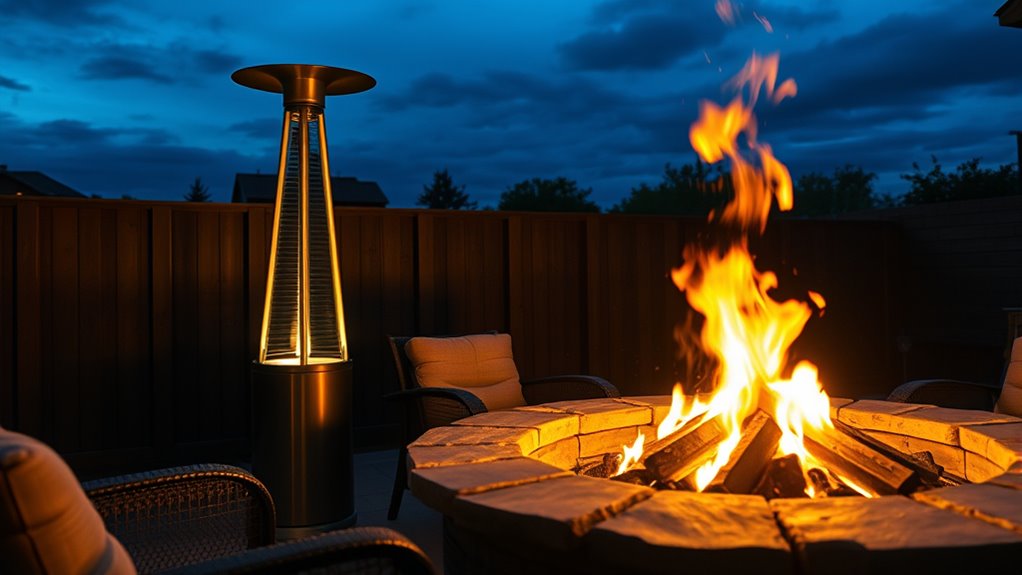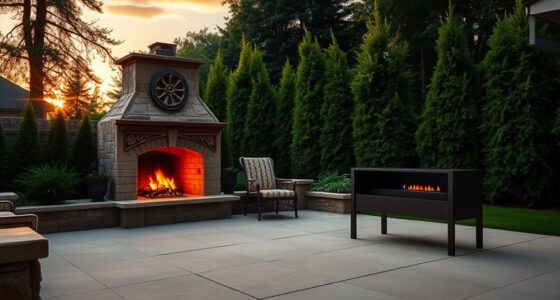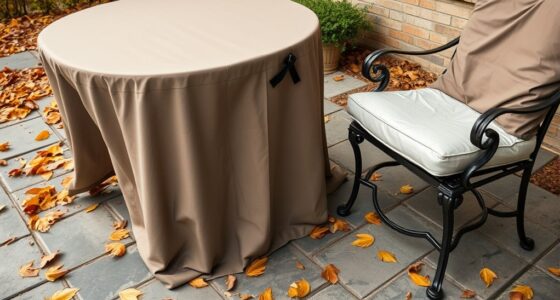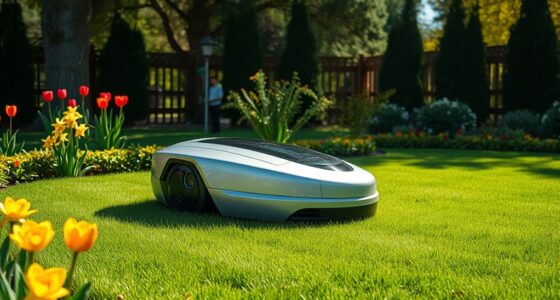If you want to stay warmer outdoors, fire pits usually produce higher BTU outputs and radiate heat in all directions, creating cozy surroundings. Patio heaters focus their warmth in a cone, often covering smaller areas but with more efficiency. Your choice depends on your space and style preferences. For a deeper understanding of how each heats and affects your outdoor experience, keep exploring the details below.
Key Takeaways
- Fire pits generally produce higher BTUs (30,000-150,000) than patio heaters, offering more intense heat for larger areas.
- Patio heaters focus heat in a specific cone, covering 2-3 meters, while fire pits radiate warmth in all directions.
- Fire pits create cozy, tactile warmth ideal for close gatherings, whereas patio heaters provide broader, more uniform warmth.
- Propane patio heaters are often more fuel-efficient and easier to operate than fire pits, which may have higher fuel costs.
- For colder climates and larger spaces, fire pits typically keep you warmer due to higher heat output.
Comparing Heat Output: BTUs and Power
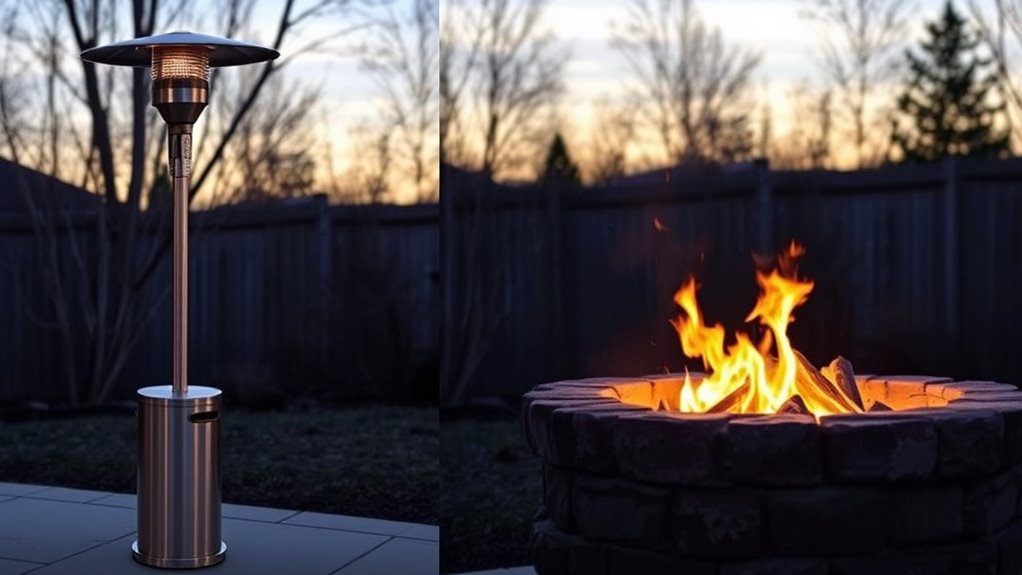
When choosing between patio heaters and fire pits, understanding their heat output is essential. Fire pits typically produce between 30,000 and 150,000 BTUs, depending on fuel type and size, offering powerful warmth. Propane fire pits range from 40,000 to 150,000 BTUs with adjustable settings, while natural gas models usually provide 30,000 to 60,000 BTUs. Wood-burning fire pits vary from 30,000 to 100,000 BTUs. In contrast, patio heaters max out around 50,000 BTUs, even for the most robust models. Larger spaces require higher BTU ratings to stay warm, especially in colder climates. Propane and natural gas fire pits deliver consistent heat, making them suitable for different outdoor environments. Fire pits tend to offer higher heat outputs than patio heaters, making them better suited for colder conditions or larger areas. Additionally, the heat distribution and ability to create a cozy ambiance often favor fire pits over patio heaters, especially when considering the heat output relative to space size.
How Heat Distribution Affects Comfort
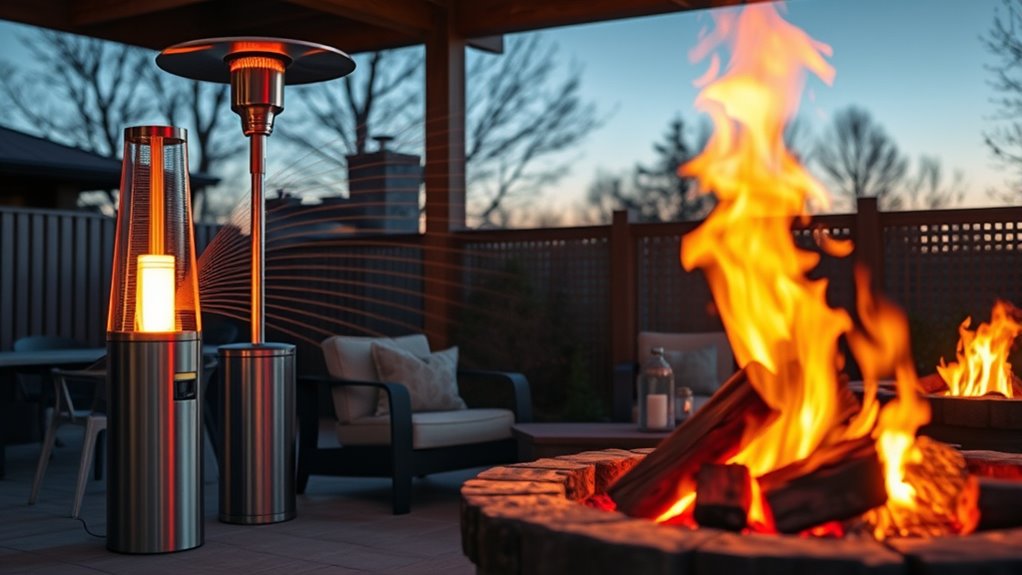
The way heat is distributed considerably impacts your outdoor comfort, especially when choosing between a fire pit and a patio heater. Fire pits radiate heat in all directions, creating a warm, enveloping glow that encourages social gatherings. People naturally cluster around the fire, but warmth can be uneven—those farther away feel cooler. Fire pits typically cover a larger area, about 4 to 5 meters, but the heat lessens with distance. In contrast, patio heaters focus warmth in a specific cone, providing consistent, directional heat within a smaller radius of 2 to 3 meters. Wind and environment influence both: open flames from fire pits dissipate faster in breezy conditions, while reflectors and shields on patio heaters help maintain targeted warmth. Your comfort depends on heat distribution and how well it suits your outdoor setup. Heat distribution patterns vary depending on the type of heater used, affecting overall comfort and usability.
Fuel Efficiency and Operational Costs

Choosing between a fire pit and a patio heater involves more than just heat distribution; understanding fuel efficiency and operational costs can substantially impact your long-term expenses.
Here’s what to evaluate:
- Fire pits often have lower upfront costs but higher ongoing fuel expenses, especially with wood or gel fuels.
- Patio heaters, especially propane models, cost more initially but usually run more efficiently, lowering fuel costs over time.
- Electric patio heaters have low fuel costs but can increase electricity bills if used frequently.
- Fuel storage varies: fire pits need wood or gel canisters, while propane patio heaters require regular tank refills, adding to maintenance costs.
- The technology used in patio heaters can influence their overall energy efficiency and operational costs over the lifespan of the unit.
Safety, Maintenance, and User Convenience
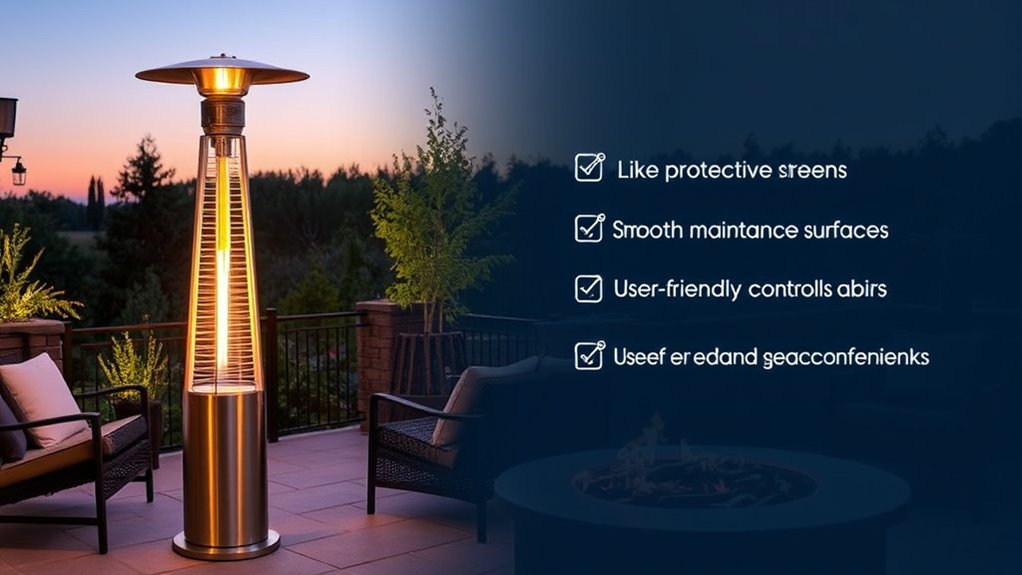
Safety, maintenance, and user convenience are crucial factors to contemplate because they directly impact your experience and safety. With fire pits, open flames demand responsible supervision, especially around children or pets. Spark screens help prevent unintended fires in windy conditions, and fire pits should stay clear of flammable materials. Proper maintenance of fire pits and heaters ensures safe operation and extends their lifespan. Patio heaters often feature auto-shutoff valves for added safety and are generally easier to move around, thanks to their portability. They also usually have simple ignition systems and adjustable heat settings, giving you more control. User convenience is enhanced by features like remote controls and easy-to-adjust settings, making operation more straightforward. Fire pits require regular cleaning and ash disposal, which can be time-consuming, while patio heaters need less maintenance. Proper storage of fuel and weather-resistant covers are essential for both options to ensure longevity and safe operation.
Ambiance vs. Practical Warmth: Creating the Perfect Outdoor Space

Creating the perfect outdoor space involves balancing aesthetic appeal with functional warmth. Fire pits create a cozy atmosphere with flickering flames, drawing people in and encouraging social activities like roasting marshmallows. They add visual ambiance and tactile warmth, making your space inviting. In contrast, patio heaters deliver discreet, modern warmth without a visible flame, focusing on practicality. They’re ideal for maintaining a comfortable environment without cluttering your yard’s look. Consider these points:
- Fire pits boost ambiance with flickering flames and social activities.
- Patio heaters offer sleek designs, blending seamlessly into decor.
- Fire pits provide localized heat, perfect for close gatherings.
- Patio heaters cast broader warmth, suitable for small groups or individual comfort.
- Both options are available in various styles and fuel types to match your outdoor decor and needs, making it easier to find the perfect fit various styles and fuel types.
- Understanding the differences in heat output and safety considerations can help you select the best option for your space, especially if you plan to use your outdoor area frequently. heat output and safety considerations
Choose based on whether ambiance or practical warmth takes priority for your outdoor space.
Frequently Asked Questions
Can Fire Pits and Patio Heaters Be Used Together Effectively?
You can definitely use fire pits and patio heaters together effectively. They complement each other by providing layered warmth—fire pits offer cozy, radiant heat and ambiance, while patio heaters cover broader areas quickly. Position them strategically to maximize efficiency, considering wind and layout. Combining both allows you to customize your outdoor comfort, ensuring everyone stays warm no matter the weather, and enhances your outdoor space’s aesthetic appeal.
Which Option Is Better for Large Outdoor Gatherings?
For large outdoor gatherings, you should consider using patio heaters, as they distribute heat evenly across a broad area and are easy to operate with adjustable settings. They’re more practical, require less maintenance, and can be mounted or moved easily, making them ideal for accommodating many guests. Fire pits create a cozy focal point but warm fewer people, so combining multiple heaters often provides better overall warmth and comfort.
Do Patio Heaters Work Well in Windy Conditions?
You might think patio heaters are helpless in wind, but some actually excel in gusty conditions. Premium propane models and gas infrared heaters can operate effectively even in strong winds up to 40 mph, dispersing heat evenly and resisting tipping. Electric infrared and weatherproof electric heaters also perform well, unaffected by wind. With sturdy bases, wind shields, and advanced technology, you can stay cozy outdoors even when the wind howls around you.
How Long Do Fire Pits and Patio Heaters Typically Operate per Fuel Load?
You wonder how long fire pits and patio heaters last on a tank. Typically, a 20-pound propane tank powers a 30,000 to 50,000 BTU heater for 8 to 10 hours. Fire pits with similar BTU ratings burn for about 3 to 7 hours per tank. Higher BTU units consume fuel faster. Keep in mind, weather conditions and flame settings influence burn time for both devices.
Are There Eco-Friendly or Sustainable Heating Options Available?
Eco-friendly heating options are definitely available for your outdoor spaces. You can choose electric infrared heaters, which emit considerably less CO2 and run on renewable energy, or opt for wood pellet heaters that use recycled wood waste and offer sustainable warmth. These options not only reduce environmental impact but also provide efficient, targeted heat, helping you stay warm while being kinder to the planet.
Conclusion
Choosing between a patio heater and a fire pit depends on your outdoor warmth needs and style. Imagine hosting a chilly evening gathering—you opt for a patio heater for consistent, easy warmth, while a fire pit adds cozy ambiance. For instance, Sarah installed a patio heater, keeping everyone comfortable, but she also loves her fire pit for weekend nights. Ultimately, pick what suits your space and vibe to create the perfect outdoor retreat.
